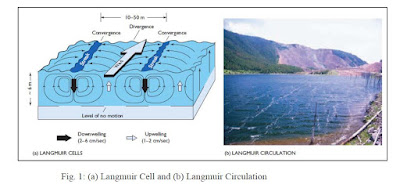Langmuir Circulation
19/10/2017
Piu Mandal*
Langmuir
Circulation is a kind of water circulation mainly driven by wind. It is the
most important topic in Physical Geography and also most important research
topic to the Oceanographer. The study of Langmuir Circulation is quite
interdisciplinary, as it is a cross idea from Physics, Chemistry, Biology and
Applied Mathematics. Langmuir Circulation process or mixing the ocean layer
mainly incorporated with fluxes of momentum, heat, mixing gases across the
air-sea interface and transport of nutrients and others. There lies a crucial
link in coupling the air and sea for mixing layer in ocean surface.
What is Langmuir
Circulation?
“Langmuir
Circulation is shallow, slow, counter-rotating vortices at the ocean's surface
aligned with the wind”. These are mainly found when wind blows over the sea
surface. This type of circulation is mainly seen when convergence of two nearby
cells form a parallel pattern on the water surface. This convergence zone or
area is popularly known as ‘Wind Streak’ or ‘Windrows’ in the field of
Oceanography. Langmuir Circulation mainly developed when wind blows on the sea
surface as a steady format. But Circulation mechanisms are not easy to
understand, as many researcher trying to find out the complex interaction
between air and wave and currents of the ocean.
Formation
of this type of ocean circulation, create a cell orientation of water flow or
movements called as Langmuir Cell. These types of cells are formed at topmost
part or at 6 meter of the water column. ‘Windrows’ or ‘Wind Streak’ is the
interaction zone of the adjacent cells in opposite direction, causing upwelling and down
welling of water volume. Convergence zone or Currents identified as presence of
streaks on the sea surface.
Discovery
In 1936,
Irving Langmuir, an eminent scientist first discover this type of circulation during
his cross-Atlantic Voyage. This type of thought had come to his mind when he
saw floating Sea weeds (Saragassum) in long, parallel linear pattern on the
water surface. Later he conducted different experiments in Lake George, New
York to explain this type of water formation. Langmuir found that the streaks which oriented approximatly
parallel to the wind, are line of surface convergence beneath which there exists
downward motion while between streaks there is
upwelling. These water motions have subsequently been called Langmuir
circulations.” (Sutcliffe, Baylor, and Menzel 1963).
Mechanisms
and Process
Langmuir
cell can be seen in oceans, seas, lakes, and even in rivers. The rotation of
water primarily known as interaction of winds, waves, and sea currents but the
exact formation is still not well defined. After a long research on this topic
‘Department of Earth and Atmospheric Science’, University of New York, mentioned
six hypotheses to explain Langmuir circulation and their associate formation of
wind streaks. These six hypotheses are: 1) Shearing Instability, 2) Atmospheric
Vortices, 3) Wind-oriented thermal convection, 4) Wind profile modification by
a surface
film, 5) Radiation
pressure on surface film, and 6) Convergence of two wave-trains.
In
shortly, primarily wind takes main role behind this type of mechanism. As
mentioned before adjoining cells are created and rotate in opposite direction,
‘Windrows’ or ‘Wind Streak’ mainly associated with convergent water or down
welling mechanism and divergent water associated with upwelling mechanisms. In
Fig.2: water circulation marked with deep blue area of adjoining cells.
Observational
characteristics of Langmuir Circulation:
·
This type of
circulation fairly observed in northern Hemisphere in between 0°-20°N latitude.
·
At the convergent zone,
floating seaweeds, foam, flowing sediment and debris are concentrated.
·
This type of
circulation, mainly imprint of convection cells.
· According to an article
in the journal Fluid Dynamics, Langmuir cells can be generated several meters
too many Kilometres in length, but depth does not excessed six meter.
·
Wind speeds ranging
from 2-12m/s maximum in this type of water circulation.
·
This type of water
circulation can formed quickly and can last from several minutes to several
days.
Lastly,
Langmuir Circulation is a convective water circulation, fairly formed in ocean,
lake, and also in river. This wind driven water motion mainly found in upper
part of ocean. As a result temperature and density of water are relatively
uniform in upper stratus of the ocean. This type of circulation pattern also
helps to predict the position Marin resources. Langmuir Circulation is very
helpful in case of accidental release of oil spill, as oil buoyant materials
are collected by this natural system.
References
1. Pinet R. Paul,
“Invitation to Oceanography”, Jones and Baretlett Publishers,Sudbury, Massachusetts, 8th edition, 2009
2. Open
University (2001), Ocean Circulation (2nd
ed.), Butterworth-Heinemann, ISBN 9780750652780
3. .Scott
,Jon T., Myer ,Glenn E., Stewart ,Ronald. and Walther ,Eric G.” ON THE
MECHANISM OF LANGMUIR CIRCULATIONS AND THEIR ROL’E IN EPILIMNION MIXING”
Department of Earth and Atmospheric Sciences, State University of New York at
Albany,Albany, N.Y. 12203
*
Honours, 2013
Part
-Time Lecturer in the Department of Geography of Women’s Christian College











Comments
Post a Comment